Childhood Obesity Health Promotion Project Report Analysis
VerifiedAdded on 2022/11/14
|7
|1301
|152
Report
AI Summary
This report details a health promotion project focused on childhood obesity (ages 6-12) in Australia. The project, conducted by a group of students, explores community needs, social determinants of obesity (including low economic status, genetics, and access to healthcare), and potential mitigation strategies. These strategies include promoting healthy eating plans through government policies and school canteen inspections, encouraging physical activity through school sports and programs, and providing regular BMI check-ups. The project also emphasizes the importance of public education and community involvement in addressing the issue. The student reflects on teamwork experiences, challenges faced (such as dominant group members and time constraints), and lessons learned regarding presentation and collaborative skills. References to supporting research on obesity prevention are also included.

Obesity 1
OBESITY
By (Student’s Name)
Professor’s Name
College
Course
Date
OBESITY
By (Student’s Name)
Professor’s Name
College
Course
Date
Paraphrase This Document
Need a fresh take? Get an instant paraphrase of this document with our AI Paraphraser
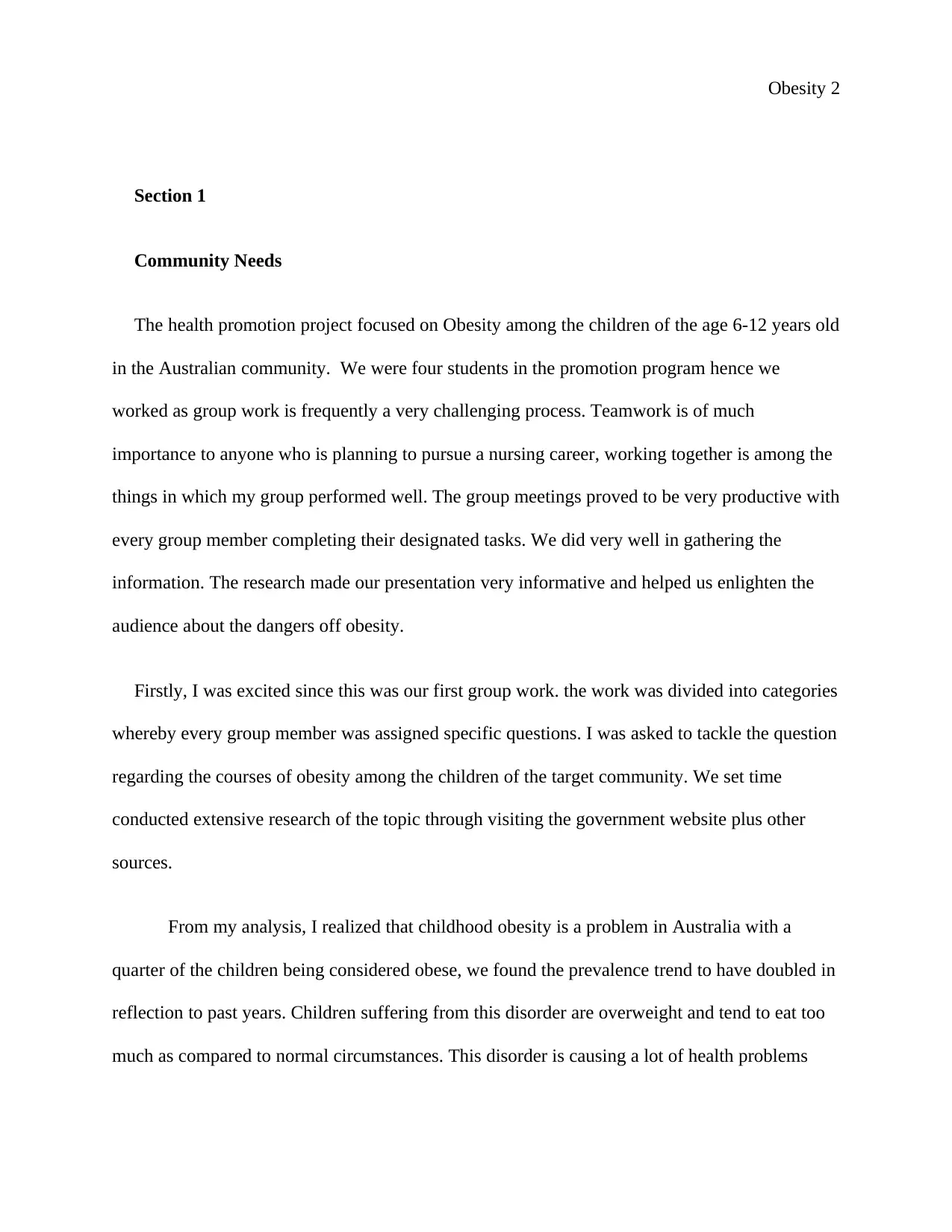
Obesity 2
Section 1
Community Needs
The health promotion project focused on Obesity among the children of the age 6-12 years old
in the Australian community. We were four students in the promotion program hence we
worked as group work is frequently a very challenging process. Teamwork is of much
importance to anyone who is planning to pursue a nursing career, working together is among the
things in which my group performed well. The group meetings proved to be very productive with
every group member completing their designated tasks. We did very well in gathering the
information. The research made our presentation very informative and helped us enlighten the
audience about the dangers off obesity.
Firstly, I was excited since this was our first group work. the work was divided into categories
whereby every group member was assigned specific questions. I was asked to tackle the question
regarding the courses of obesity among the children of the target community. We set time
conducted extensive research of the topic through visiting the government website plus other
sources.
From my analysis, I realized that childhood obesity is a problem in Australia with a
quarter of the children being considered obese, we found the prevalence trend to have doubled in
reflection to past years. Children suffering from this disorder are overweight and tend to eat too
much as compared to normal circumstances. This disorder is causing a lot of health problems
Section 1
Community Needs
The health promotion project focused on Obesity among the children of the age 6-12 years old
in the Australian community. We were four students in the promotion program hence we
worked as group work is frequently a very challenging process. Teamwork is of much
importance to anyone who is planning to pursue a nursing career, working together is among the
things in which my group performed well. The group meetings proved to be very productive with
every group member completing their designated tasks. We did very well in gathering the
information. The research made our presentation very informative and helped us enlighten the
audience about the dangers off obesity.
Firstly, I was excited since this was our first group work. the work was divided into categories
whereby every group member was assigned specific questions. I was asked to tackle the question
regarding the courses of obesity among the children of the target community. We set time
conducted extensive research of the topic through visiting the government website plus other
sources.
From my analysis, I realized that childhood obesity is a problem in Australia with a
quarter of the children being considered obese, we found the prevalence trend to have doubled in
reflection to past years. Children suffering from this disorder are overweight and tend to eat too
much as compared to normal circumstances. This disorder is causing a lot of health problems
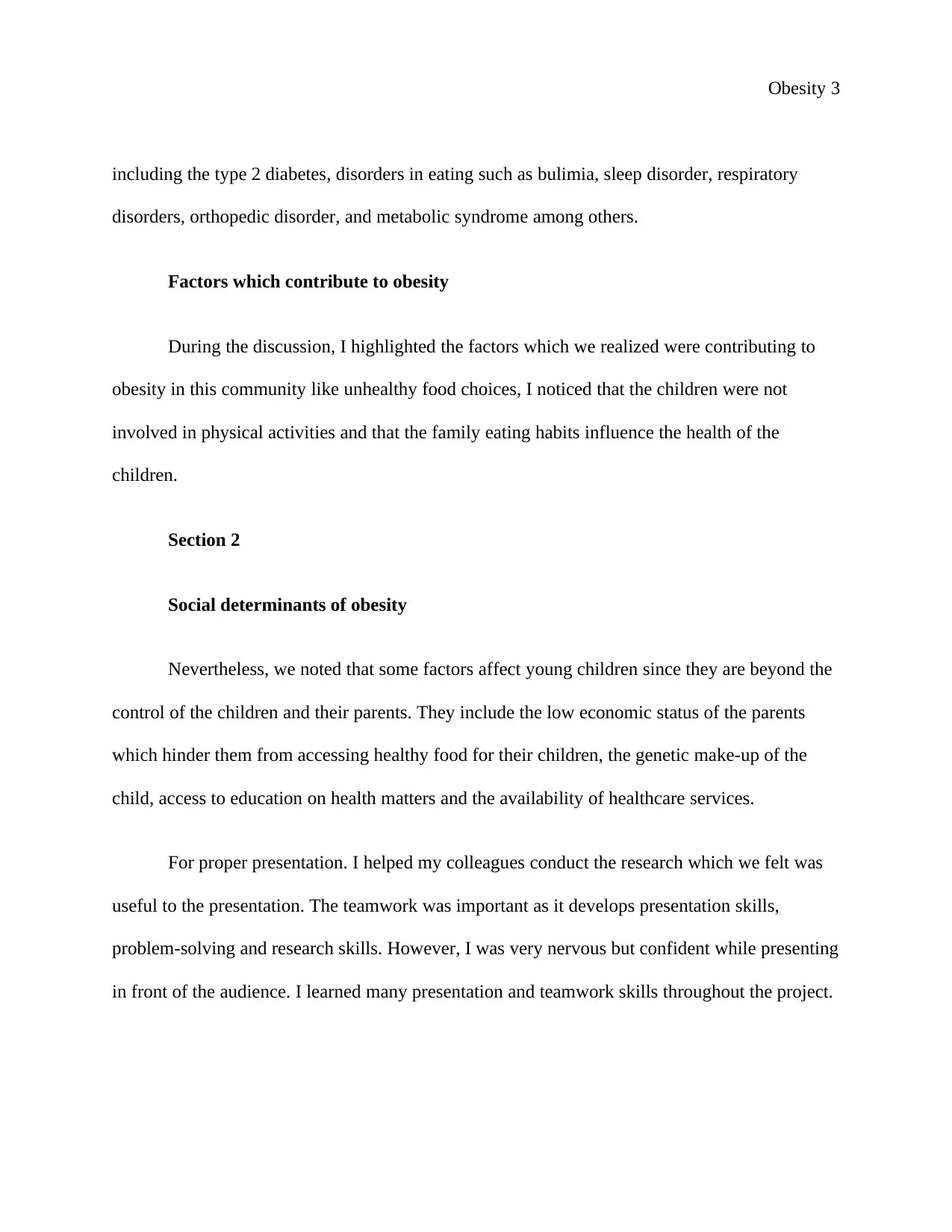
Obesity 3
including the type 2 diabetes, disorders in eating such as bulimia, sleep disorder, respiratory
disorders, orthopedic disorder, and metabolic syndrome among others.
Factors which contribute to obesity
During the discussion, I highlighted the factors which we realized were contributing to
obesity in this community like unhealthy food choices, I noticed that the children were not
involved in physical activities and that the family eating habits influence the health of the
children.
Section 2
Social determinants of obesity
Nevertheless, we noted that some factors affect young children since they are beyond the
control of the children and their parents. They include the low economic status of the parents
which hinder them from accessing healthy food for their children, the genetic make-up of the
child, access to education on health matters and the availability of healthcare services.
For proper presentation. I helped my colleagues conduct the research which we felt was
useful to the presentation. The teamwork was important as it develops presentation skills,
problem-solving and research skills. However, I was very nervous but confident while presenting
in front of the audience. I learned many presentation and teamwork skills throughout the project.
including the type 2 diabetes, disorders in eating such as bulimia, sleep disorder, respiratory
disorders, orthopedic disorder, and metabolic syndrome among others.
Factors which contribute to obesity
During the discussion, I highlighted the factors which we realized were contributing to
obesity in this community like unhealthy food choices, I noticed that the children were not
involved in physical activities and that the family eating habits influence the health of the
children.
Section 2
Social determinants of obesity
Nevertheless, we noted that some factors affect young children since they are beyond the
control of the children and their parents. They include the low economic status of the parents
which hinder them from accessing healthy food for their children, the genetic make-up of the
child, access to education on health matters and the availability of healthcare services.
For proper presentation. I helped my colleagues conduct the research which we felt was
useful to the presentation. The teamwork was important as it develops presentation skills,
problem-solving and research skills. However, I was very nervous but confident while presenting
in front of the audience. I learned many presentation and teamwork skills throughout the project.
⊘ This is a preview!⊘
Do you want full access?
Subscribe today to unlock all pages.

Trusted by 1+ million students worldwide
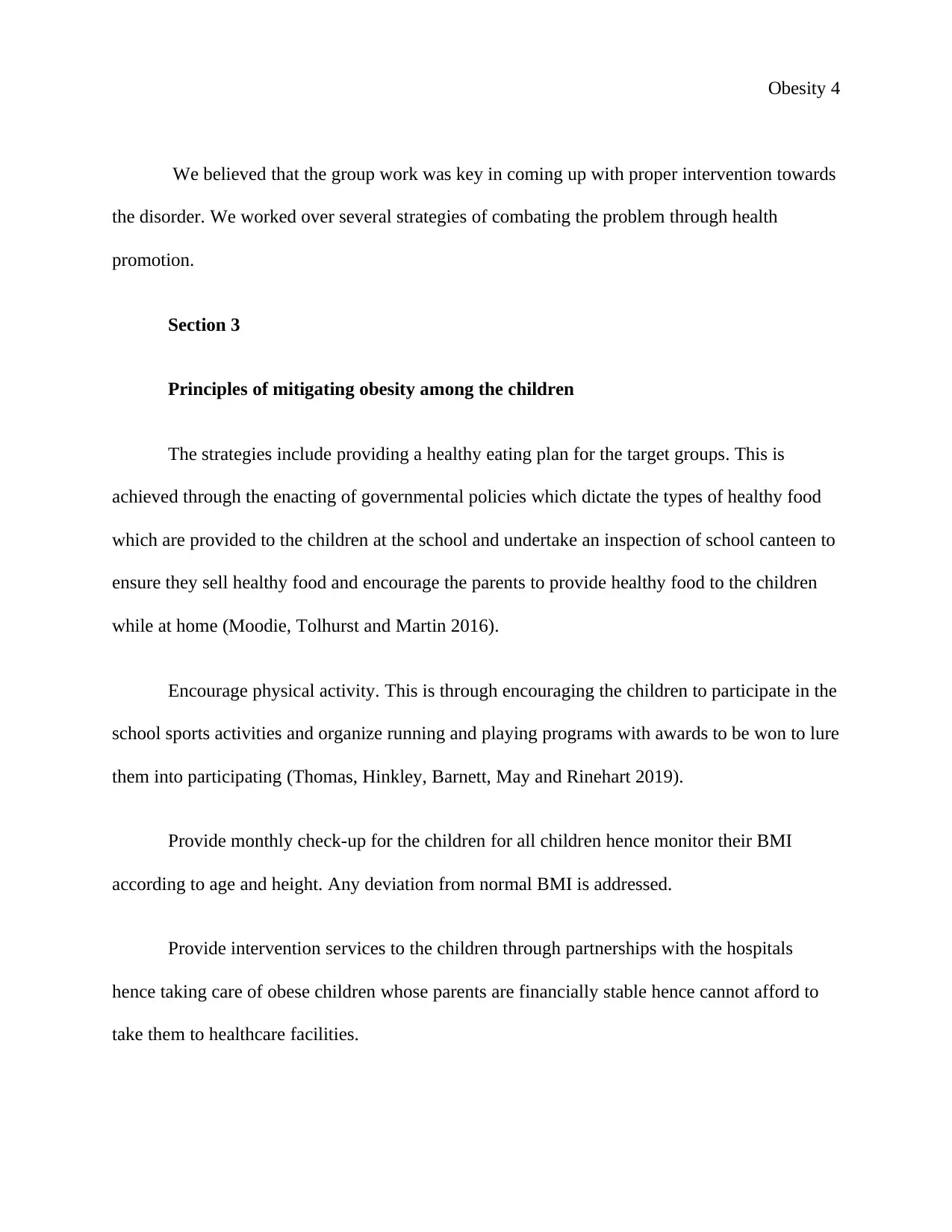
Obesity 4
We believed that the group work was key in coming up with proper intervention towards
the disorder. We worked over several strategies of combating the problem through health
promotion.
Section 3
Principles of mitigating obesity among the children
The strategies include providing a healthy eating plan for the target groups. This is
achieved through the enacting of governmental policies which dictate the types of healthy food
which are provided to the children at the school and undertake an inspection of school canteen to
ensure they sell healthy food and encourage the parents to provide healthy food to the children
while at home (Moodie, Tolhurst and Martin 2016).
Encourage physical activity. This is through encouraging the children to participate in the
school sports activities and organize running and playing programs with awards to be won to lure
them into participating (Thomas, Hinkley, Barnett, May and Rinehart 2019).
Provide monthly check-up for the children for all children hence monitor their BMI
according to age and height. Any deviation from normal BMI is addressed.
Provide intervention services to the children through partnerships with the hospitals
hence taking care of obese children whose parents are financially stable hence cannot afford to
take them to healthcare facilities.
We believed that the group work was key in coming up with proper intervention towards
the disorder. We worked over several strategies of combating the problem through health
promotion.
Section 3
Principles of mitigating obesity among the children
The strategies include providing a healthy eating plan for the target groups. This is
achieved through the enacting of governmental policies which dictate the types of healthy food
which are provided to the children at the school and undertake an inspection of school canteen to
ensure they sell healthy food and encourage the parents to provide healthy food to the children
while at home (Moodie, Tolhurst and Martin 2016).
Encourage physical activity. This is through encouraging the children to participate in the
school sports activities and organize running and playing programs with awards to be won to lure
them into participating (Thomas, Hinkley, Barnett, May and Rinehart 2019).
Provide monthly check-up for the children for all children hence monitor their BMI
according to age and height. Any deviation from normal BMI is addressed.
Provide intervention services to the children through partnerships with the hospitals
hence taking care of obese children whose parents are financially stable hence cannot afford to
take them to healthcare facilities.
Paraphrase This Document
Need a fresh take? Get an instant paraphrase of this document with our AI Paraphraser
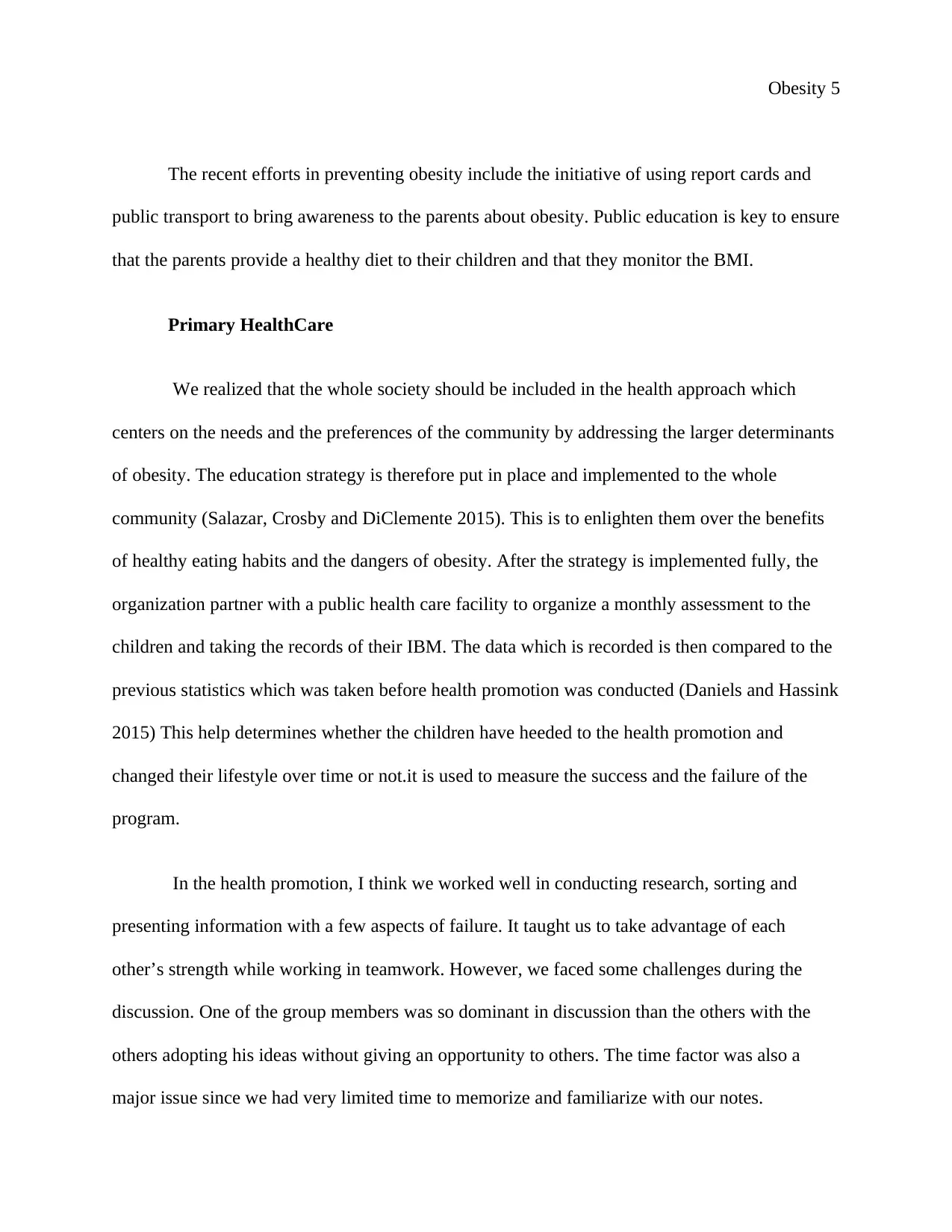
Obesity 5
The recent efforts in preventing obesity include the initiative of using report cards and
public transport to bring awareness to the parents about obesity. Public education is key to ensure
that the parents provide a healthy diet to their children and that they monitor the BMI.
Primary HealthCare
We realized that the whole society should be included in the health approach which
centers on the needs and the preferences of the community by addressing the larger determinants
of obesity. The education strategy is therefore put in place and implemented to the whole
community (Salazar, Crosby and DiClemente 2015). This is to enlighten them over the benefits
of healthy eating habits and the dangers of obesity. After the strategy is implemented fully, the
organization partner with a public health care facility to organize a monthly assessment to the
children and taking the records of their IBM. The data which is recorded is then compared to the
previous statistics which was taken before health promotion was conducted (Daniels and Hassink
2015) This help determines whether the children have heeded to the health promotion and
changed their lifestyle over time or not.it is used to measure the success and the failure of the
program.
In the health promotion, I think we worked well in conducting research, sorting and
presenting information with a few aspects of failure. It taught us to take advantage of each
other’s strength while working in teamwork. However, we faced some challenges during the
discussion. One of the group members was so dominant in discussion than the others with the
others adopting his ideas without giving an opportunity to others. The time factor was also a
major issue since we had very limited time to memorize and familiarize with our notes.
The recent efforts in preventing obesity include the initiative of using report cards and
public transport to bring awareness to the parents about obesity. Public education is key to ensure
that the parents provide a healthy diet to their children and that they monitor the BMI.
Primary HealthCare
We realized that the whole society should be included in the health approach which
centers on the needs and the preferences of the community by addressing the larger determinants
of obesity. The education strategy is therefore put in place and implemented to the whole
community (Salazar, Crosby and DiClemente 2015). This is to enlighten them over the benefits
of healthy eating habits and the dangers of obesity. After the strategy is implemented fully, the
organization partner with a public health care facility to organize a monthly assessment to the
children and taking the records of their IBM. The data which is recorded is then compared to the
previous statistics which was taken before health promotion was conducted (Daniels and Hassink
2015) This help determines whether the children have heeded to the health promotion and
changed their lifestyle over time or not.it is used to measure the success and the failure of the
program.
In the health promotion, I think we worked well in conducting research, sorting and
presenting information with a few aspects of failure. It taught us to take advantage of each
other’s strength while working in teamwork. However, we faced some challenges during the
discussion. One of the group members was so dominant in discussion than the others with the
others adopting his ideas without giving an opportunity to others. The time factor was also a
major issue since we had very limited time to memorize and familiarize with our notes.
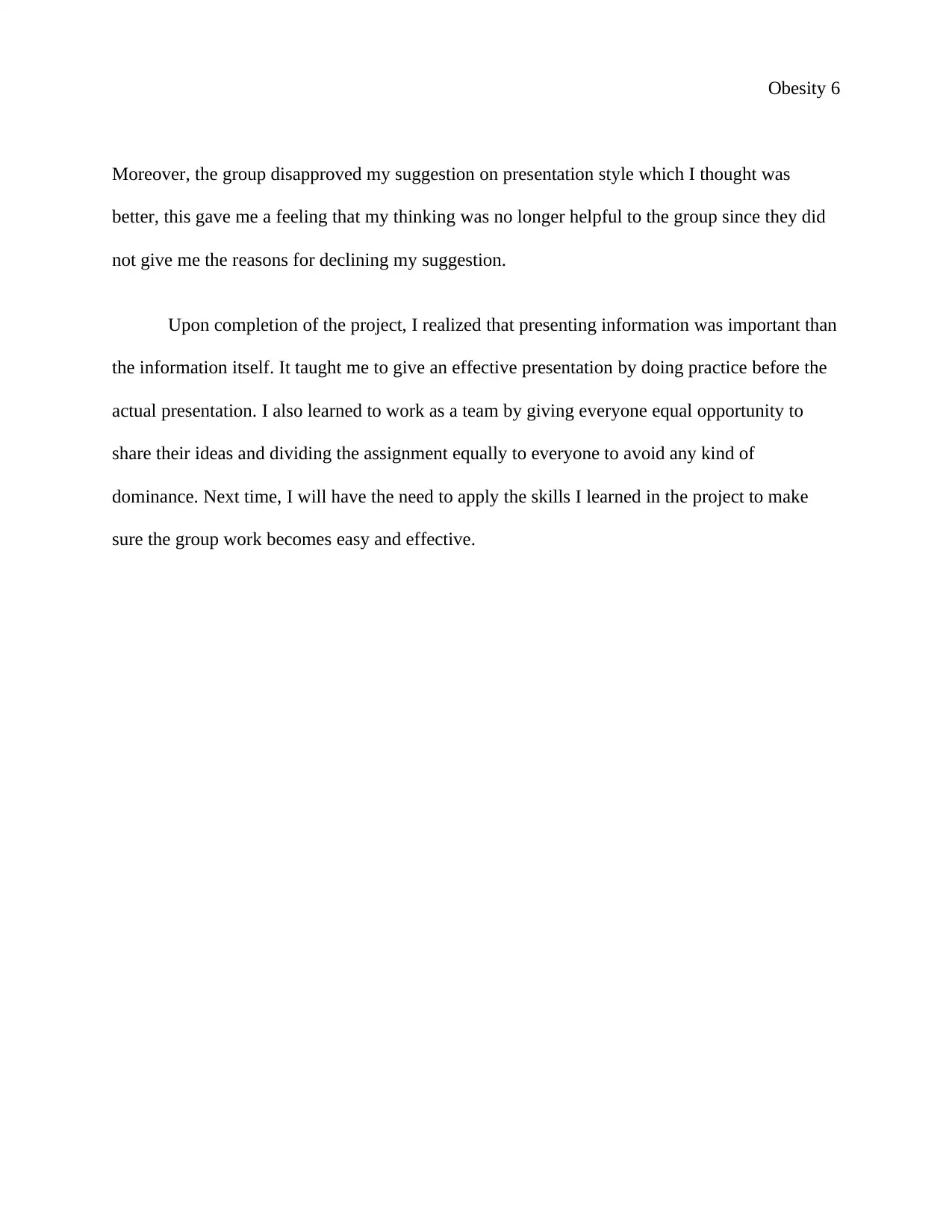
Obesity 6
Moreover, the group disapproved my suggestion on presentation style which I thought was
better, this gave me a feeling that my thinking was no longer helpful to the group since they did
not give me the reasons for declining my suggestion.
Upon completion of the project, I realized that presenting information was important than
the information itself. It taught me to give an effective presentation by doing practice before the
actual presentation. I also learned to work as a team by giving everyone equal opportunity to
share their ideas and dividing the assignment equally to everyone to avoid any kind of
dominance. Next time, I will have the need to apply the skills I learned in the project to make
sure the group work becomes easy and effective.
Moreover, the group disapproved my suggestion on presentation style which I thought was
better, this gave me a feeling that my thinking was no longer helpful to the group since they did
not give me the reasons for declining my suggestion.
Upon completion of the project, I realized that presenting information was important than
the information itself. It taught me to give an effective presentation by doing practice before the
actual presentation. I also learned to work as a team by giving everyone equal opportunity to
share their ideas and dividing the assignment equally to everyone to avoid any kind of
dominance. Next time, I will have the need to apply the skills I learned in the project to make
sure the group work becomes easy and effective.
⊘ This is a preview!⊘
Do you want full access?
Subscribe today to unlock all pages.

Trusted by 1+ million students worldwide
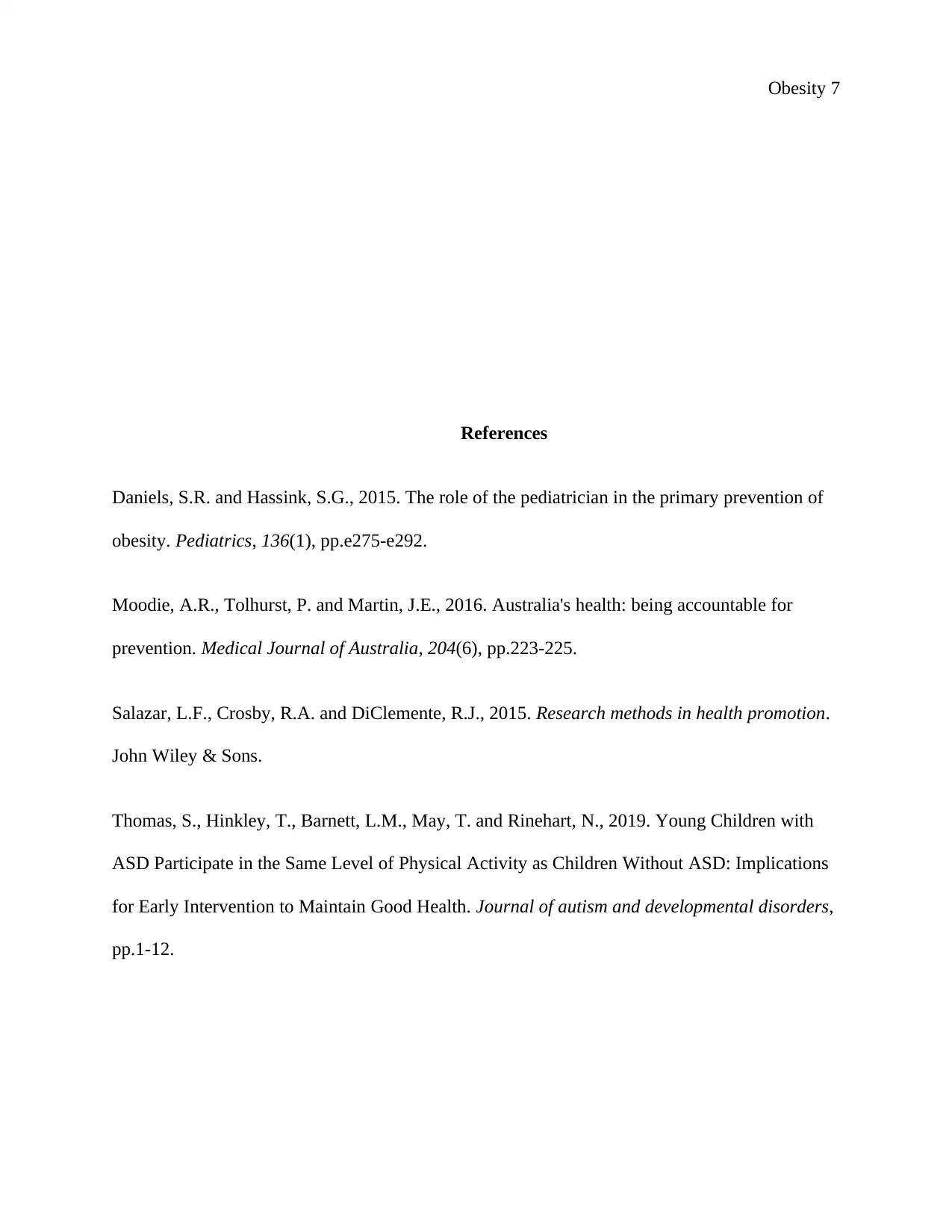
Obesity 7
References
Daniels, S.R. and Hassink, S.G., 2015. The role of the pediatrician in the primary prevention of
obesity. Pediatrics, 136(1), pp.e275-e292.
Moodie, A.R., Tolhurst, P. and Martin, J.E., 2016. Australia's health: being accountable for
prevention. Medical Journal of Australia, 204(6), pp.223-225.
Salazar, L.F., Crosby, R.A. and DiClemente, R.J., 2015. Research methods in health promotion.
John Wiley & Sons.
Thomas, S., Hinkley, T., Barnett, L.M., May, T. and Rinehart, N., 2019. Young Children with
ASD Participate in the Same Level of Physical Activity as Children Without ASD: Implications
for Early Intervention to Maintain Good Health. Journal of autism and developmental disorders,
pp.1-12.
References
Daniels, S.R. and Hassink, S.G., 2015. The role of the pediatrician in the primary prevention of
obesity. Pediatrics, 136(1), pp.e275-e292.
Moodie, A.R., Tolhurst, P. and Martin, J.E., 2016. Australia's health: being accountable for
prevention. Medical Journal of Australia, 204(6), pp.223-225.
Salazar, L.F., Crosby, R.A. and DiClemente, R.J., 2015. Research methods in health promotion.
John Wiley & Sons.
Thomas, S., Hinkley, T., Barnett, L.M., May, T. and Rinehart, N., 2019. Young Children with
ASD Participate in the Same Level of Physical Activity as Children Without ASD: Implications
for Early Intervention to Maintain Good Health. Journal of autism and developmental disorders,
pp.1-12.
1 out of 7
Related Documents
Your All-in-One AI-Powered Toolkit for Academic Success.
+13062052269
info@desklib.com
Available 24*7 on WhatsApp / Email
![[object Object]](/_next/static/media/star-bottom.7253800d.svg)
Unlock your academic potential
Copyright © 2020–2025 A2Z Services. All Rights Reserved. Developed and managed by ZUCOL.





